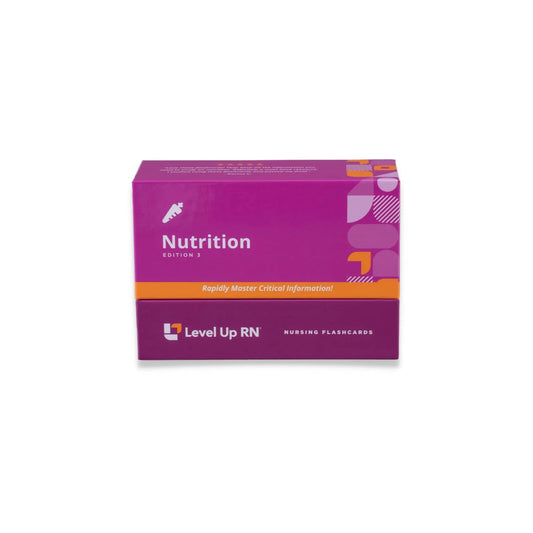When you see this Cool Chicken, that indicates one of Cathy's silly mnemonics to help you remember. The Cool Chicken hints in these articles are just a taste of what's available across our Level Up RN Flashcards for nursing students!
Welcome to the Nutrition Essentials for Nursing video and article series. This series follows along with our Nutrition Essentials for Nursing Flashcards which are intended to help RN and PN nursing students study for nursing school exams, including the ATI, HESI, and NCLEX.
Nutrition plays a key role in patient wellness, and patient teaching regarding nutrition is a key part of EVERY nurse’s job. These flashcards will help you understand the basics of nutrition, along with key nutritional and lifestyle considerations for common health disorders.
Nutrition Essentials - Nursing Flashcards
Nutrition topics in this playlist
These are the topics (so far!) that we will cover in the Nutrition Essentials for Nursing playlist. These are also topics you should study for your exams!
- Introduction, Overview of Nutrients (this video)
- Macronutrients: Carbohydrates, Lipids, Protein
- Water Soluble Vitamins: B-complex vitamins, vitamin C
- Fat Soluble Vitamins: Vitamins A, D, E, K
- ...to be continued!
Nutrients overview
All nutrients in our diet can be divided into macronutrients and micronutrients.
Macronutrients
Macronutrients are made up of carbohydrates, lipids and proteins.
Carbohydrates
Carbohydrates should make up between 45 - 65% of calories per day. Each gram of carbohydrates contains 4 kilocalories of energy.
Lipids (fats)
Lipids (fats) should make up between 20 - 35% of calories per day. Each gram of fat contains 9 kilocalories of energy.
Protein
Protein should make up between 10 - 35% of calories per day. Each gram of protein contains 4 kilocalories of energy.
What are kilocalories?
When talking about diet and nutrition, kilocalories and calories are used interchangeably. Technically there are "small calories" (calories) and "large calories" (kilocalories), and a small calorie is 1/1000th of a large calorie. But hardly anyone besides chemistry researchers measure in small calories, so therefore the calories that we all talk about and see on nutrition labels, are kilocalories, and we just call them calories!
Micronutrients
Micronutrients can be broken down into vitamins and minerals.
Vitamins
Vitamins can be broken down into water-soluble vitamins and fat-soluble vitamins
Water-soluble vitamins
Water-soluble vitamins include B-complex vitamins (vitamins B1, B2, B3, B5, B6, B7, B9, and B12) and vitamin C. Water-soluble vitamins require regular replacement in the body.
Fat-soluble vitamins
Fat-soluble vitamins include vitamins A, D, E and K. Fat-soluble vitamins are stored in the liver and fatty tissue for a long time, which can cause an increased risk of toxicity when consumed in excess.
Minerals
Minerals in our diet can be grouped into major minerals, which are electrolytes, and trace minerals.
Major minerals
Major minerals are our electrolytes, which help our body be able to perform major functions, like our heart beating. Major minerals include calcium, chloride, magnesium, phosphorus, potassium, and sodium.
Trace minerals
Trace minerals are important too, but we require them in smaller amounts. Trace minerals include copper, fluoride, iodine, iron, selenium and zinc.


